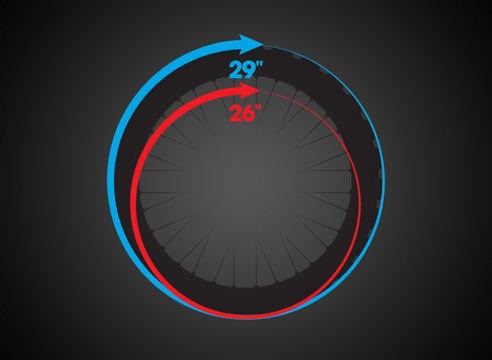 Not So Long Ago There Were Only 26" Wheels For Mountain Bikes. Now There Are So Many Options. How Should You Choose?
Not So Long Ago There Were Only 26" Wheels For Mountain Bikes. Now There Are So Many Options. How Should You Choose?
29" wheels aren't great for everything, but now that the threshold has been crossed, other bike innovators revived the intermediate 650b (27.5") wheel size that would hopefully be the "perfect mix."
Many bike manufacturing companies have now all but replaced their traditional 26" bikes for the better handling, fitting, and looks of the 650b style bike.
As a mountain biker, how do you choose which tire size would best suit you? Check out this guide to discover the benefits of each.
 26"
26"The original wheel size might have been an accidental standard based on beach cruisers, but it still has a lot going for it.
For a start, smaller diameter rims and shorter spokes mean 26" wheels can be made lighter and more responsive than other sizes. That means a more agile feeling, faster accelerating bike on smooth surfaces.
They can also be made stiffer and stronger too, which is why most top downhill riders are still sticking with 26" wheels.
Spares are much easier to find than 29" and far far more common than 650b replacements. That makes it much easier to get going again if you puncture a tube, tear a tire or crumple a wheel far from home. That's obviously another bonus for downhillers and jump bike riders, who are the most likely to destroy their gear.
Because they hit stuff at a steeper angle and drop into holes easier, they clatter and lose speed more rapidly than bigger wheels in the rough though. They're not as stable steering or as grippy as 650b or 29er formats of the same tires either.
650B/ 27.5"
29ers certainly made it easier for the MTB industry to introduce a third wheel size, but we're still shocked how fast 650B has been accepted.
The first thing to realize is that the wheels aren't actually 27.5" but closer to 27". As a result they're significantly faster to accelerate and easier to flick around than a bigger 29er wheel.
There's less steering inertia and flex in the handling too, so handling feels more responsive and balanced. The wheels are still small enough to work with long travel suspension frames and forks without them feeling or looking weird.
650B tires still roll over rough ground more smoothly and grip noticeably better than 26" equivalents, although not as well as 29" wheels.
Because the new wheel size has been introduced so suddenly, most manufacturers are struggling to make enough bits for complete bikes, let alone extras for shop stocks. That means spares are alot harder to find in a hurry so stocking up in advance is wise. Most manufacturers are still concentrating their 650B efforts on trail and enduro bikes too, so specialist cross-country and downhill machines are thin on the ground.
 29"
29"
The wheel that broke the strangehold of 26" produces a very different feel. Because 29ers are larger, they're generally heavier and harder to get moving.
Their size and stability also means it's taken a while for bike designers to make big wheeled bikes handle in a fun way. They're still harder to hustle on really tight twisty or jump and pump trails compared to smaller wheels. It's also more difficult to make big wheels and small frames or long travel suspension fit together too. Crucially, because they're not as quick to get going and their smoothness dulls the sensation of speed they often feel much slower than they actually are. Add sometimes awkward looks and it's easy to see why 29ers took a while to catch on.
Once rolling though, 29ers hit rocks and roots at a shallower angle and with more momentum so they roll over the top easier. The longer contact patch means any given tire grips better or you can run slicker, speedier rubber without slipping. Add their natural extra stability and they're perfect for powering straight through trouble at high speed.
There's a full range of different styles of 29er bikes to choose from now too, although most are still focused on the cross-country and trail categories.
Final Tips
— The smallest wheel size is still the strongest where strength matters most.
— Just starting out? A 29er will help if you aren't so confident on the trail. — Then again, cross country riders that want to finish first should also consider 29ers, as they are faster on less technical, high speed race courses and open trail
Come to Bumstead's Bicycles for all your cycling needs.
We are located at 1038 W. 4th St in Ontario, CA.
You can reach us by phone at (909) 984-9067




















